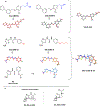Boosting the Discovery of Small Molecule Inhibitors of Glucose-6-Phosphate Dehydrogenase for the Treatment of Cancer, Infectious Diseases, and Inflammation
- PMID: 35239352
- PMCID: PMC9553131
- DOI: 10.1021/acs.jmedchem.1c01577
Boosting the Discovery of Small Molecule Inhibitors of Glucose-6-Phosphate Dehydrogenase for the Treatment of Cancer, Infectious Diseases, and Inflammation
Abstract
We present an overview of small molecule glucose-6-phosphate dehydrogenase (G6PD) inhibitors that have potential for use in the treatment of cancer, infectious diseases, and inflammation. Both steroidal and nonsteroidal inhibitors have been identified with steroidal inhibitors lacking target selectivity. The main scaffolds encountered in nonsteroidal inhibitors are quinazolinones and benzothiazinones/benzothiazepinones. Three molecules show promise for development as antiparasitic (25 and 29) and anti-inflammatory (32) agents. Regarding modality of inhibition (MOI), steroidal inhibitors have been shown to be uncompetitive and reversible. Nonsteroidal small molecules have exhibited all types of MOI. Strategies to boost the discovery of small molecule G6PD inhibitors include exploration of structure-activity relationships (SARs) for established inhibitors, employment of high-throughput screening (HTS), and fragment-based drug discovery (FBDD) for the identification of new hits. We discuss the challenges and gaps associated with drug discovery efforts of G6PD inhibitors from in silico, in vitro, and in cellulo to in vivo studies.
Conflict of interest statement
We declare no competing interests.
Figures















Similar articles
-
Discovery of new uncompetitive inhibitors of glucose-6-phosphate dehydrogenase.J Biomol Screen. 2014 Dec;19(10):1362-71. doi: 10.1177/1087057114546896. Epub 2014 Aug 13. J Biomol Screen. 2014. PMID: 25121555
-
Discovery and characterization of a novel glucose-6-phosphate dehydrogenase (G6PD) inhibitor via high-throughput screening.Bioorg Med Chem Lett. 2021 May 15;40:127905. doi: 10.1016/j.bmcl.2021.127905. Epub 2021 Mar 6. Bioorg Med Chem Lett. 2021. PMID: 33689874
-
Discovery of Small-Molecule Activators for Glucose-6-Phosphate Dehydrogenase (G6PD) Using Machine Learning Approaches.Int J Mol Sci. 2020 Feb 23;21(4):1523. doi: 10.3390/ijms21041523. Int J Mol Sci. 2020. PMID: 32102234 Free PMC article.
-
NMR-Fragment Based Virtual Screening: A Brief Overview.Molecules. 2018 Jan 25;23(2):233. doi: 10.3390/molecules23020233. Molecules. 2018. PMID: 29370102 Free PMC article. Review.
-
High-Throughput Screening by Nuclear Magnetic Resonance (HTS by NMR) for the Identification of PPIs Antagonists.Curr Top Med Chem. 2015;15(20):2032-42. doi: 10.2174/1568026615666150519102459. Curr Top Med Chem. 2015. PMID: 25986689 Free PMC article. Review.
Cited by
-
Semisynthetic Ecdysteroid Cinnamate Esters and tert-Butyl Oxime Ether Derivatives with Trypanocidal Activity.J Nat Prod. 2024 Oct 25;87(10):2478-2486. doi: 10.1021/acs.jnatprod.4c00811. Epub 2024 Oct 17. J Nat Prod. 2024. PMID: 39417525 Free PMC article.
-
The Multifaceted Opportunities Provided by the Pheomelanin-Inspired 1,4-Benzothiazine Chromophore: A Still-Undervalued Issue.Molecules. 2023 Aug 25;28(17):6237. doi: 10.3390/molecules28176237. Molecules. 2023. PMID: 37687069 Free PMC article. Review.
-
Human papillomavirus-16 E6 activates the pentose phosphate pathway to promote cervical cancer cell proliferation by inhibiting G6PD lactylation.Redox Biol. 2024 May;71:103108. doi: 10.1016/j.redox.2024.103108. Epub 2024 Mar 1. Redox Biol. 2024. PMID: 38457903 Free PMC article.
-
The Emerging Roles of the Metabolic Regulator G6PD in Human Cancers.Int J Mol Sci. 2023 Dec 7;24(24):17238. doi: 10.3390/ijms242417238. Int J Mol Sci. 2023. PMID: 38139067 Free PMC article. Review.
-
Ultrasound-triggered biomimetic ultrashort peptide nanofiber hydrogels promote bone regeneration by modulating macrophage and the osteogenic immune microenvironment.Bioact Mater. 2023 Aug 14;31:231-246. doi: 10.1016/j.bioactmat.2023.08.008. eCollection 2024 Jan. Bioact Mater. 2023. PMID: 37637084 Free PMC article.
References
-
- Tian W-N; Braunstein LD; Pang J; Stuhlmeier KM; Xi Q-C; Tian X; Stanton RC, Importance of Glucose-6-phosphate Dehydrogenase Activity for Cell Growth. J. Biol. Chem 1998, 273 (17), 10609–10617. - PubMed
-
- Hutchings D; Rawsthorne S; Emes MJ, Fatty Acid Synthesis and the Oxidative Pentose Phosphate Pathway in Developing Embryos of Oilseed Rape (Brassica napus L.). J. Exp. Bot 2004, 56 (412), 577–585. - PubMed
-
- Kornberg A; Horecker BL; Horecker BL; Smyrniotis PZ, [42] Glucose-6-phosphate dehydrogenase 6-Phosphogluconic Dehydrogenase. In Methods in Enzymology, Academic Press: 1955; Vol. 1, pp 323–327.
Publication types
MeSH terms
Substances
Grants and funding
LinkOut - more resources
Full Text Sources
Other Literature Sources
Chemical Information
Medical
Miscellaneous

